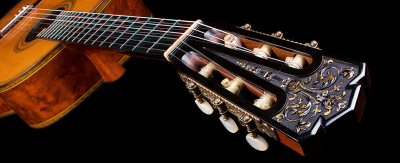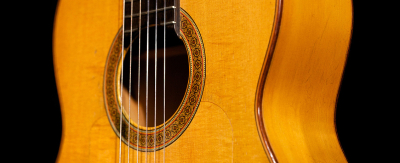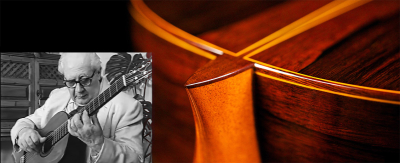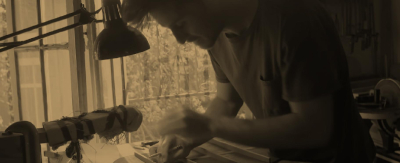Tomatito Interview (and many more great interviews)
I’ve known Brook Zern since the late ’80s when I was studying with Dennis Koster in New York. Brook, who worked in publishing, would come to the AIG (American Institute of Guitar) and play during his lunch hour – I sometimes marveled at his ability to practice while reading the NY Times – and he was always very generous about answering all my questions. He seemed to know a lot about this flamenco business. Brook has been committed to the flamenco cause to the point that in 2008 he was actually knighted by king Juan Carlos of Spain for his work in disseminating Spanish culture in the U.S. (the only foreigner to be so honored).
He has a new blog where he holds court on tons of flamenco-related topics and recently has begun translating and reprinting some fantastic interviews, like the one here with Tomatito, which is definitely worth a read. One of the most interesting ones I’ve read was the interview with none other than Don Antonio Chacón, and there are interviews with Paco de Lucía, Matilde Coral and many more, all of which include Brook’s opinionated commentary – Brook is an unabashed proponent of Gypsy flamenco and the Morón style.
There are an awful lot of opinions about flamenco out there on the web, so it’s nice to know that on this site it’s all backed by actual knowledge of the history of flamenco and a life devoted to studying and living it – which is to say that I’ll always take the informed opinion (whether or not I agree with it) over the alternative.
Check out the Tomatito interview below and check out Brook’s Blog for more great stuff.
“One of the best Spanish websites for flamenco is www.aireflamenco.com. The edition for March 16 has an interview by Jaci González with the great guitarist Tomatito, titled “Tomatito is flamenco, and much more as well”.
Now, if you don’t read Spanish but would still like to cut me out of the loop, it seems you can just push the Google Translate / English button on top to have it converted into – well, something akin to English, although often utterly incoherent, as is almost inevitable where an arcane subject like flamenco is involved.
Today, for the first time, I pushed that button. It seems Tomatito says in part, “In my house, a count, played by seguiriya. I took two unpublished letters of shrimp…” “I do not want a letter of shrimp, and come dwell. I wanted a bill of shrimp, a falsetto, and now.” “We’ll talk to the evolution of shrimp in those years even.”
This, believe it or not, is much better than robotranslations used to be, but it still leaves something to be desired, unless you happen to be a paleobiologist specializing in crustacea except during odd-numbered years.
(In my confident belief that I can out-translate the latest billion-dollar Google algorithm, I remind myself of another superhero of story and song in whose giant footsteps I follow. Yes, you guessed it: I’m just like the legendary John Henry, last of the steel-driving men, who decided to prove he could outperform the first steam drill. And he, like me, triumphed.. And yes, people will remember me always: “He died with his keyboard in his hand, Lord, Lord, died with his keyboard in his hand.”)
(It sounds better than “He died with his laptop on his lap,” don’t you think?)
Where was I? Oh, yes: Here’s the article as I understood it:
Headline: Tomatito is flamenco, and so much more
After his CD’s “Spain Again”, with [Dominican jazz pianist and composer] Michel Camilo, and “Sonanta Suite” with the National Orchestra of Spain, Tomatito has just completed a project that is essential in his professional trajectory: “Soy flamenco”. Nearly a decade after his last recording on which flamenco was the main protagonist, he has returned to prove that he is one of the principal artists within a universal art, and an indispensable reference point for the flamenco guitar. Because Tomatito, in his roots and in his origin, is flamenco. That’s what he told us on an end-of-winter afternoon in Clan, a flamenco restaurant in Madrid…
Q: What does “Soy Flamenco” (literally “I Am Flamenco”) mean for you?
A: That title came to me because, among recent developments, I’ve just made a CD with the Spanish National Orcestra and another with Michel Camilo… The last actual flamenco record I made was “Aguadulce”, and this is like returning again. It means that I am flamenco, I have never left my roots or my way of playing.
Q: “Soy Flamenco” is also the title of the bulerías that opens the album, where Mari Angeles (Tomatito’s young daughter) sings better than we do.
A: Ha, ha – she does it with such love, singing with her father. It was a nice touch; I’m her dad, so she agreed. I hope the public likes it, and thinks it’s pretty.
Q: This time around you’ve created several bulerías, but coming at them from different conceptual standpoints, different paths…
A: In the first one, “Soy Flamenco”, I did an introduction using tremolo [a technique rarely used in bulerías], a little melody, and the falsetas [melodic variations] are done on just one guitar, with Mari Angeles singing, followed by little choruses with Kiki, my son-in-law, who’s from Galicia. The second bulerías is titled “Despacito” [“Slowly, slowly”] because I wanted it to have a less pronounced rhythmic pulse; and I invited Guadiana to compose a little verse [letrita]…
Q: “Despacito” is seemingly less rhythmic, but it has its “punto habanero” [referring to a Cuban feel.]
A: Yes, exactly – half Cuban, with some little notes jumping over from that country. The other bulerías is dedicated to Moraíto [the great Jerez guitarist who died young last year], and I play [overdub] two guitars, something like “If you were here, you’d play along with me”; I wanted to dedicate it to him with all my respect and all my love and affection [cariño], as if we were playing together.
Q: There’s also that ferocious [bestial] bulerías with Paco de Lucía and Camarón [the great singer who died in 1992 – his name, incidentally, means “the shrimp”]. How did that come about?
A: Well, I was listening to a hard disc with songs by Camarón, and this was originally a tangos [a flamenco form with a very different rhythmic pattern or compás]. With Protools [a music program] we made a claqueta [maybe a rhythmic click-track, onto which music can be superimposed]. And I said, “Paco, I’m doing this, just in case you’re tempted…” Paco was tied up with a record of coplas [sentimental Spanish popular songs, very popular in the forties and fifties and enjoying a renaissance ever since Miguel Poveda, perhaps Spain’s favorite flamenco singer, devoted a smash-hit record to them] – but he said, “Well, if I’m tempted; okay, send it to me.” I did, and he made the arrangement at home, putting the verses into the timing; then we played the guitars together, and its priceless [precioso]. Technically, it’s really done by hand – you have to know just where to put everything. It’s not mechanical or machine-like, though it was done using a machine; it was a matter of putting it in the right place. It was a process that took many hours of work – many hours. One day, then the next day, until everything was in its place and it could be played like a bulerías.
Q: Tremendous…
A: Tremendous, but lovely work.
Q: Then, suddenly a monumental siguiriyas with Camarón.
A: In my house, with a click-track, I played a siguiriyas. Then I took two unpublished verses by Camarón, from those I have recorded but have never been released on records or anywhere. I worked on it at home, alone. I did a little introduction, a falseta…I wanted the siguiriyas to be, as the title indicates, “The Present”, a gift. I didn’t want to do a siguiriyas on guitar and then have a verse by Camarón, and venga explayarme. What I wanted was an introduction, a verse, a falseta, and that’s it [“y ya” = “y ya está”]. But then I found another verse that seemed to be for a bulerías, and I put it into the siguiriyas form, and that’s when I said that it was all done.
Q: In this newly revealed siguiriyas of Camarón, you show another facet of yourself, because it’s one thing to be a guitar soloist, but what we have here is the fine accompanist for singers, which is a whole different story. To give room for the gift.
A: That’s what I wanted to do, a gift for the afición, for the lovers of Camarón [camaroneros]. And judging from those who’ve heard it, I thing they are grateful.
Q: An odd thing: Camarón, twenty years later, is singing better than ever. We can now talk of the evolution of his art even in this new era.
A: Yes, even now we are talking about things like “did you see the special touch [detalle] that he adds here?” “Look at the salida [entrance] he does here here!” For instance, in the siguiriyas, this way of vocalizing – I know that the Camarón fanatics will go nuts…
Q: The siguiriyas is enough to drive you crazy.
A: Yes, yes, it’s like “What is this?” “What’s that?” I’m happy, and happy for the afición as well. You can say that even now, people listen closely to Camarón.
Q: In most cases when you move away from flamenco to other musical terrains, it has been very jazzístico [“jazzistic”]. But this time, when we come to George Benson, instead of recalling his jazziest things, you go more toward his pop and funk side, as in numbers like “Breezin’” – at the same time, the music is very much in your own domain. Did you suddenly wake up one morning with this idea?
A: More specifically, Benson for me is the guitarist who does funk [hace el funky] better than anyone else. The way he sings, the way he plays, its beautiful the way he phrases; he’s my idol. But of course, the language and the tonality is always quite distinct, but you don’t want to do a jazz piece. But okay, in this style he has already done it in jazz, better than anyone. I wanted to do a funky piece that evokes Benson, but in the flamenco tonality – in the Phrygian mode and the harmonies that the flamencos use, without going into the major key. In the flamenco tonality, pure and simple [puro y duro = pure and hard/tough].
Q: El Maca in this piece is “sembrao”, and Corti, too.
A: El Maca is a great bassist who understands un vey well, and El Cortina also has a good vibe.
Q: The project closes with a version of “Our Spain”, the piece that was done fifteen years ago by Charlie Haden and Pat Metheny in “Beyond the Missouri Sky”. How did you think up this closing touch?”
A: I like Youtube a lot, and one day I was checking out Metheny’s stuff and heard this piece that sounded very Spanish, like Spanish canción. I began playing it, and saw that I like it, that it was easy on the ear, and pretty. Because I’m always so curious, I had to stick my foot in it…ha, ha, then it occurred to me that, well, in every recording I do, I have to put my foot into jazz in one way or another!
Q: Your version also has an unusual aspect, because the original is a duo between Metheny’s guitar and Charlie’s contrabass, and you’ve done it with Javier Colina on contrabass but also with the piano arrangements that Alfonso Pérez plays.
A: That was an idea from Josep Salvador, a friend of mine. I asked him for some criteria about this. We went to Cinearte, I did it with Colina and Alfonso Pérez, and then I called a Cuban drummer friend. Josep Salvador helped me a lot – you know who I’m talking about, the guitarist who went on tour with Alejandro Sanz…
Q: Of course, he goes on all of Sanz’s tours.
A: Exactly.
Q: How do you see the future of flamenco?
A: It looks fine to me, as long as there are artists who defend it, with clear ideas about what flamenco really is. For example, you can do a lot of things on the guitar, but you need a clear sense of flamenco identity, for when you want to come back to it. When you play for a singer, a soleá is a soleá, and the same for a siguiriyas or a tarantas. The guitar has a lot of places to go, but you must know exactly where you are at all times.
Q: Will the day finally come when we have a flamenco guitar with a foldable neck – the Airport Friendly Flamenco Guitar [in English]?
A: Ha, ha – maybe, because they are putting so many obstacles in the way of getting guitars onto planes. When that kind of guitar comes out…For those of us who travel, we’d certainly have to buy it. ¡Por cojones! [Perhaps as in, “They have us by the…” well, you get the gist.] Ha, ha, ha.
Q: Life can be tough at times.
A. True enough – they tell you that you buy a ticket for your guitar or they’ll put it down in the baggage compartment. I’m going to London on the 19th, and they’re telling me that I should put it in one of the cases I have at home, that it’s fatal to carry it on – or buy it a ticket, or something. Before, you just put the guitar up in the overhead, and it fit perfectly, but no longer.
Q: Tomatito’s dream?
A: Health, and a good life for all, so we can listen to music with more love and fewer problems.
End of translation of Jaci González’s interview with Tomatito.
It’s always nice when flamenco guitarists stumble back from wherever they’ve been and dip their toes into actual flamenco. Tomatito has always been insatiable in his need to break free from the confines of the art.
In the seventies, when he was a kid in Málaga, Tomatito met my American friend Carlos Lomas who knew a lot about music in general. Carlos had done an album that was half Arabic oud and half flamenco guitar and would later record the world’s first real flamenco fusion album (or so it seems to me – see the blog entry about Carlos and the record, called “Adelante” or “Forward”.) Carlos showed him a lot flamenco and a lot of other music, which he absorbed with prodigious aplomb, and he still remembers Carlos with respect and affection.
In 1961, my father had a friend who lived in Woodstock and went around the country collecting folk music. Since the 1940’s, my father had been learning flamenco guitar from a gentleman named Fidel Zabal, who was a close friend of Sabicas. Together, my father and his friend made private recordings of Fidel and of Sabicas, virtually the only documents of Sabicas’s playing in that decade.
Why am I telling you this? Because my father’s friend had a bunch of guitars, and one of them was an early-twentieth-century Ramirez, perhaps by Manuel, with a neck that was cut off near the body and reattached with a door hinge. I played it, it worked, and it sounded good. It had its own special case, not much bigger than a briefcase, that would fit into any overhead compartment, well, except Ryanair’s.
Why was this idea forgotten, and why has it taken a half-century for someone to refloat this invention as the Airport Friendly Flamenco Guitar? Why are people so stupid?
What? You say I should have had the brains to patent and market the door-hinge guitar back then, so I could’ve afforded to retire now?
And you also think I’m being too cranky about the jazzophilia that is plaguing flamenco guitarists these days? Well, the same publication has a March 19th article that says you can hear the world’s greatest flamenco guitarist by going to Vitoria, Spain on July 20th.
Needless to say, you probably won’t hear any flamenco guitar, or at least more than a few minutes of it. Instead, you’ll see Paco de Lucía trying to figure out where Chick Corea’s head is at these days, in their first re-encounter since 2001, while Mr. Corea will give no sign that he’d like to learn any of the great flamenco music that Mr. de Lucía dispenses at will.
(Actually, the program will begin with Chick and his current quartet, The Vigil. Then Paco does his thing with his Sextet, which was mostly his stunningly advanced and jazz-oriented flamenco when I saw the group in Boston last fall. It concludes with the re-encounter, both men accompanied by that the report calls “sus bandas”, their bands).
(In Pretty Woman, yet another chick-flick I love, the sophisticated Mr. Gere takes the floozy Julia Roberts to an opera because he needs to be seen with someone attractive. The curtain rises, the orchestra starts to play the overture, and Julia Roberts’ face lights up. “Look”, she says. “There’s a band!”
(Spoiler alert: They get married. IMHO, he marries far above his station – just sayin’.)
And my point, assuming I had one, is that it wasn’t a band at the opera. It was an orchestra. And when a flamenco guitarist goes onstage with a flamenco group, it is a flamenco group. Unless – unless the flamenco guitarist has strayed so far from flamenco that the backing entity is that jazziest of ensembles, a band.
Yes, it’s a band. But !Ojo! [Eye! – meaning “Pay attention!”] – there is no such thing as a flamenco band. That is an oxymorón.
Morón? Did someone say Morón? Bring back the sixties, I say, before Paco de Lucía invented harmony…and before Protools became an indispensable part of flamenco.”
– Brook Zern [email protected]
0 comment







